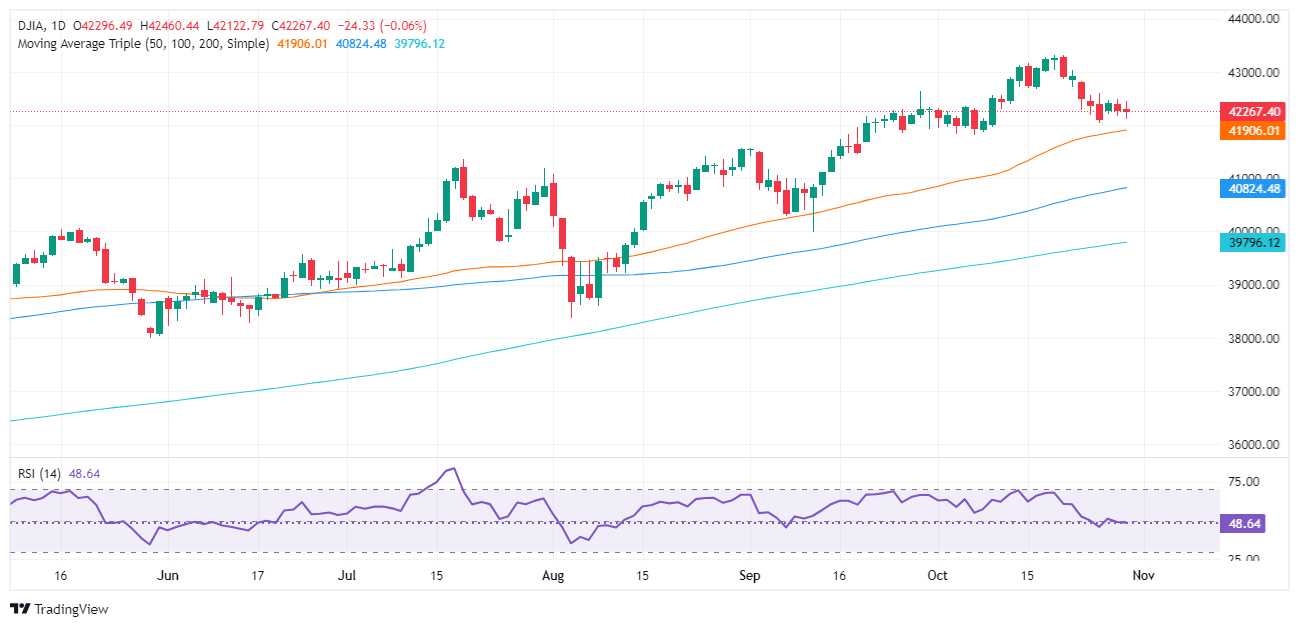- Dow Jones climbs as US economy grows 2.8% in Q3, suggesting a soft landing despite slightly missing Q2’s 3% pace.
- ADP reports hefty job gains in October, indicating robust labor demand.
- Visa leads DJIA gainers after beating earnings expectations, while Caterpillar struggles after missing EPS estimates for Q3.
The Dow Jones Industrial Average (DJIA) advanced during the North American session, with bulls eyeing a break above 42,500 as US Treasury bond yields tumbled. The economy in the US grew below estimates but at a healthy pace. At the same time, jobs data revealed by Automatic Data Processing (ADP) showed the labor market is strengthening after announcing an outstanding jobs report.
The US Bureau of Economic Analysis revealed that the economy grew 2.8% YoYin Q3 2024, according to its preliminary reading. Although it missed the mark and Q2’s 3%, the numbers suggest the economy is on its way to achieving a soft landing, as the Federal Reserve (Fed) lowers borrowing costs to stimulate the labor market.
Regarding this, the ADP National Employment Change report showed that private companies added 233K people to the workforce in October, crushing estimates of 115K. Nela Richardson, chief economist at ADP, said in a statement, “Even amid hurricane recovery, job growth was strong in October.” In the meantime, US bond yields retreated after hitting a three-month high of 4.337% and dropped 0.65% or three basis points (bps) to 4.248%.
After the data, the CME FedWatch Tool shows odds for a 25 bps rate cut by the Fed reaching 97%, down from 98% a day ago. This would leave rates in the 4.50%-4.75% range.
Dow Jones news
The earnings session continued as Visa (V) led the pack in the DJIA after the company announced fiscal Q4 2024 earnings. Visa revealed that earnings per share (EPS) was $2.71, up from estimates of $2.58, while revenue increased to $9.6 billion, exceeding forecasts of $9.48 billion. At the same time, the company cut 1,400 jobs.
Caterpillar (CAT) plunged before recovering as the company revealed lower-than-expected Q3 earnings. Adjusted earnings per share (EPS) came at $5.17, below estimates of $5.34, though revenue increased to $16.11 billion, exceeding estimates of $16.08 billion. The company projects sales and revenue to be slightly lower than expected at the end of the last quarter.
At the time of writing, Visa leads the DJIA, gaining 3.68% to $292.25. Boeing (BA) gained 2.07% to $156.14, and Amazon (AMZN) lifted 1.62% to $193.93. The laggards are International Business Machines (IBM) losing 1.95% to $206.33, followed by Nike (NKE) sinking 1.76% to $77.02, and Intel(INTC) diving 1.72% to $22.51.
Dow Jones price forecast
The Dow Jones consolidates at around 42,300 but cannot decisively crack the 42,400 mark, which would open the door to challenge 42,500.
At the beginning of the session, sellers pushed the DJIA toward a low of 42,122 near the October 25 low of 42,043, though buyers bought the dip before the index tested the 50-day Simple Moving Average (SMA) at 41,907. After that, the Dow Jones recovered some ground, clinging to minimal gains.
If buyers reclaim 42,500, look for a test of the October 23 peak at 42,830 ahead of testing 43,000 and the record high at 43,322.
Otherwise, if the Dow extends its losses below 42,000, the first support would be the 50-day SMA, ahead of 41,500.
Momentum remains bullish as depicted by the Relative Strength Index (RSI), which pierced above its neutral line. However, it has consolidated, suggesting that neither buyers nor sellers are in control.
Dow Jones daily chart
Dow Jones FAQs
The Dow Jones Industrial Average, one of the oldest stock market indices in the world, is compiled of the 30 most traded stocks in the US. The index is price-weighted rather than weighted by capitalization. It is calculated by summing the prices of the constituent stocks and dividing them by a factor, currently 0.152. The index was founded by Charles Dow, who also founded the Wall Street Journal. In later years it has been criticized for not being broadly representative enough because it only tracks 30 conglomerates, unlike broader indices such as the S&P 500.
Many different factors drive the Dow Jones Industrial Average (DJIA). The aggregate performance of the component companies revealed in quarterly company earnings reports is the main one. US and global macroeconomic data also contributes as it impacts on investor sentiment. The level of interest rates, set by the Federal Reserve (Fed), also influences the DJIA as it affects the cost of credit, on which many corporations are heavily reliant. Therefore, inflation can be a major driver as well as other metrics which impact the Fed decisions.
Dow Theory is a method for identifying the primary trend of the stock market developed by Charles Dow. A key step is to compare the direction of the Dow Jones Industrial Average (DJIA) and the Dow Jones Transportation Average (DJTA) and only follow trends where both are moving in the same direction. Volume is a confirmatory criteria. The theory uses elements of peak and trough analysis. Dow’s theory posits three trend phases: accumulation, when smart money starts buying or selling; public participation, when the wider public joins in; and distribution, when the smart money exits.
There are a number of ways to trade the DJIA. One is to use ETFs which allow investors to trade the DJIA as a single security, rather than having to buy shares in all 30 constituent companies. A leading example is the SPDR Dow Jones Industrial Average ETF (DIA). DJIA futures contracts enable traders to speculate on the future value of the index and Options provide the right, but not the obligation, to buy or sell the index at a predetermined price in the future. Mutual funds enable investors to buy a share of a diversified portfolio of DJIA stocks thus providing exposure to the overall index.
Information on these pages contains forward-looking statements that involve risks and uncertainties. Markets and instruments profiled on this page are for informational purposes only and should not in any way come across as a recommendation to buy or sell in these assets. You should do your own thorough research before making any investment decisions. FXStreet does not in any way guarantee that this information is free from mistakes, errors, or material misstatements. It also does not guarantee that this information is of a timely nature. Investing in Open Markets involves a great deal of risk, including the loss of all or a portion of your investment, as well as emotional distress. All risks, losses and costs associated with investing, including total loss of principal, are your responsibility. The views and opinions expressed in this article are those of the authors and do not necessarily reflect the official policy or position of FXStreet nor its advertisers. The author will not be held responsible for information that is found at the end of links posted on this page.
If not otherwise explicitly mentioned in the body of the article, at the time of writing, the author has no position in any stock mentioned in this article and no business relationship with any company mentioned. The author has not received compensation for writing this article, other than from FXStreet.
FXStreet and the author do not provide personalized recommendations. The author makes no representations as to the accuracy, completeness, or suitability of this information. FXStreet and the author will not be liable for any errors, omissions or any losses, injuries or damages arising from this information and its display or use. Errors and omissions excepted.
The author and FXStreet are not registered investment advisors and nothing in this article is intended to be investment advice.
Recommended content
Editors’ Picks

EUR/USD remains bid around 1.1200, USD melts on tariff concerns
EUR/usd maintains its bullish stance well in place on Thursday, reaching the 1.1200 barrier and beyond on the back of intense selling pressure on the US Dollar, fuelled by concerns over the impact of Trump's tariffs on the US economy.

GBP/USD settles around 1.2950 on weaker Dollar
GBP/USD advances markedly and extends its breakout of the 1.2900 hurdle amid global trade war jitters and a severe sell-off in the Greenback, which was exacerbated following news of 145% US tariffs on China.

Gold resumes record rally, reaches $3,175
Gold extended its record rally on fresh tariff-related headlines, trading as high as $3,175 a troy ounce in the American session. The White House confirmed 35% levies on Mexico and Canada, 145% on Chinese imports, resulting in a fresh round of USD selling and pushing XAU/USD further up.

Cardano stabilizes near $0.62 after Trump’s 90-day tariff pause-led surge
Cardano stabilizes around $0.62 on Thursday after a sharp recovery the previous day, triggered by US Donald Trump’s decision to pause tariffs for 90 days except for China and other countries that had retaliated against the reciprocal tariffs announced on April 2.

Trump’s tariff pause sparks rally – What comes next?
Markets staged a dramatic reversal Wednesday, led by a 12% surge in the Nasdaq and strong gains across major indices, following President Trump’s unexpected decision to pause tariff escalation for non-retaliating trade partners.

The Best brokers to trade EUR/USD
SPONSORED Discover the top brokers for trading EUR/USD in 2025. Our list features brokers with competitive spreads, fast execution, and powerful platforms. Whether you're a beginner or an expert, find the right partner to navigate the dynamic Forex market.




